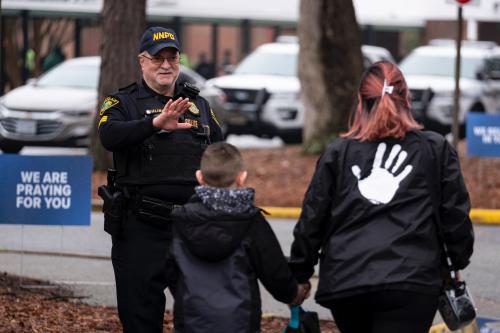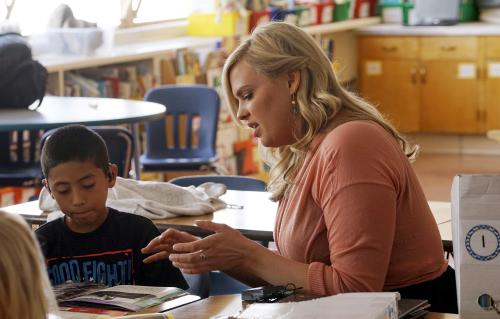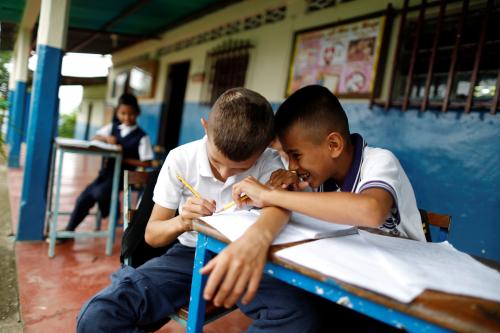School resource officers (SROs), law enforcement personnel that are responsible for safety and crime prevention in schools, have been in place for more than six decades. In the wake of high-profile school shootings, SROs are receiving renewed attention as integral components of school safety strategies. Despite widespread usage, we know very little about whether safety outcomes improve because of SROs.
In a recent study, I rigorously evaluated the effectiveness of Senate Bill 402, Section 8.36, passed by the General Assembly of North Carolina, a grant program that provided selected school districts with $2 for every $1 spent to hire or train SROs in elementary and middle schools. Specifically, I compared disciplinary acts of 460 middle schools over a seven-year period (some of which received the matching funds, and some of which did not), before and after the policy was implemented. I used several statistical techniques to make “apples-to-apples” comparisons of school safety outcomes.
When describing their SRO grant program, the North Carolina Department of Public Instruction offered the following position statement: “Students gain trust in law enforcement by interacting positively with their school’s SRO, and SROs provide both a deterrent to violence and a first response to events if they should occur.” Here, I discuss how my evaluation of this grant program adds to our knowledge of the effect of SROs and offer several policy recommendations based on this work.
Previous research on school resource officers
Despite the North Carolina position statement, research shows that increased frequencies of interactions between students and SROs were not related to feelings of safety at school. Rather, student experiences at school were better predictors of feeling of safety. Males, students who have strong connectedness with schools, and students who had positive attitudes towards SROs reported feeling safer in schools. However, females, African-American students, and students who have experienced various forms of school violence, such as fights, arguments, bullying, or religious teasing, reported feeling less safe in schools, even though SROs were present.
There is evidence that SROs can build good relationships with students. For example, positive student outcomes were achieved when North Carolina SROs went above the call of duty to coach a middle school basketball team when no one else was available. Contrarily, there are also countless viral videos from around the country of SROs physically abusing youth for minor incidents, some of which have led to lawsuits and now permeate the minds of young adolescents.
Lessons from a new study
Based on my study of the North Carolina SRO matching grant program, described above, here are four lessons learned for initiating successful school safety policy and practices.
Lesson 1: Increasing investments in school resource officers does not lead to safer schools.
The position statement mentioned above asserts that SROs provide a deterrent to violence. Is this really true?
When comparing schools within districts that received additional funding for SROs to schools within districts that did not, I found no relationships between additional dollars received and reductions in the 16 disciplinary acts that must be reported to the state. Some of the 16 disciplinary outcomes include various forms of assault, homicide, bomb threats, possession and use of alcohol and drugs, possession of weapons, and more.
Approximately $23 million taxpayer dollars were spent to supplement local district funding for SROs in North Carolina between 2013 and 2017. During the 2013-2017 period, the annual amounts represented less than 1 percent of the state’s budget. Relatively speaking, the dollar amounts were not excessive. Yet, in 2018-2019, $12 million dollars of a new $35 million dollar grant were appropriated for school resource officer grants in North Carolina for elementary and middle schools. Such increases in school safety investments must be supported with evidence and not just ideology.
I agree with a National Association of School Resource Officers report that notes that it is “difficult to inventory all that an SRO can do for a campus and its surrounding community.” Moreover, it is certainly inappropriate to quantify the costs of saving lives, which school resource officers have done. However, it is also important to examine how doubling down with more SROs can have negative, life-altering effects for students.
For example, there is evidence of racial disparities in arrests by SROs. Two juvenile judges found that student arrests and juvenile court referrals increase when SROs are present in schools. It is important to acknowledge that increased arrests do not necessarily mean that schools are safer. These judges also noted that a primary responsibility of police officers is to make arrests when there is probable cause. These probable cause judgments may be contributing to disparities in law enforcement referrals for specific racial groups. Indeed, another recent report found major disparities in school-based arrests of black and white students in North Carolina.
Lesson 2: School characteristics explain only a small portion of differences in disciplinary outcomes.
In my study, I incorporated a technique known as multilevel modeling to isolate how much variation in disciplinary acts can be explained by differences between schools within districts versus non-school based factors. The model showed that for schools that reported at least one disciplinary act, approximately 15 percent of the differences in disciplinary outcomes can be explained by differences in school-based characteristics, whereas approximately 85 percent of the differences in disciplinary acts by school are explained by non-school factors. In other words, if SROs did their jobs completely and flawlessly, there are still a host of variables outside of the schooling context that contribute to school safety issues. Although I did not study outside factors, some outside predictors could include neighborhood and social conditions, prior histories of abuse, participation in online hate groups, and more. In other words, school safety is not just a problem that can be addressed in schooling contexts.
Lesson 3: School size (enrollment) and academic achievement are strong predictors of school safety.
I found that the 16 disciplinary outcomes did improve in North Carolina, as a whole, over time, but these improvements were not related to increased SRO funding. My models predicted that if total school enrollment increased by 10 percent, then disciplinary acts would likely increase between 8.4 percent and 10 percent if all other factors in the model remained the same. On the other hand, if grade-level proficiency increased by 5 percent, then the models predicted that disciplinary acts would likely decrease by approximately 20 percent. In short, large or underachieving middle schools are likely to have more safety concerns, regardless of the racial makeup. Thus, alternative investments in smaller middle schools and strategies for improving learning outcomes might accomplish greater school safety outcomes.
Lesson 4. Race is a poor predictor of school safety, and better reporting practices are needed.
The annual report of crime and suspensions submitted to the General Assembly of North Carolina places a heavy emphasis on disaggregating data by race and gender. However, no data are disaggregated by achievement levels. In my models, I simultaneously evaluated grade-level proficiency indicators and racial composition of schools, finding that racial composition of schools is not predictive of school safety in middle school.
These findings show that when reporting disciplinary data by race, without considering other issues, such as achievement levels, race may appear to be a stronger predictor of school safety outcomes than it really is. Future reports should disaggregate safety outcomes by achievement levels and school size. Moreover, when reporting disciplinary statistics, reports should combine race and gender with achievement levels, to compare, for example, disciplinary acts between high-achieving versus low-achieving students across race and gender. This puts the focus back on the primary purpose of schools, education, and its relationship to discipline outcomes, rather than solely focusing on race and gender.
Conclusion
Legislative activity increases after school shootings occur, but rushed school safety legislation may be ineffective. The North Carolina bill, along with similar laws in other states, was passed shortly after the 2012 Newtown tragedy. After traumatic events occur, those who are affected are often outraged, frightened, and devastated, creating an appetite for policy changes. These short periods are known as policy windows.
When policy windows open, the windows are often short, and the legislative process can move rapidly. For example, in the month after the Parkland school shooting tragedy occurred on Feb. 14, 2018, four school safety bills were introduced by Congress. These four bills, described in detail here, primarily focus on reducing gun violence and are clearly reactionary to the Parkland tragedy. However, thoughtful school safety policy should be carefully crafted over time rather than being motivated solely by high-profile events. School safety policy must not solely focus on mass acts of violence, but should embrace a broader perspective of school safety, which includes developmentally appropriate interventions and physical and psychological safety.
Legislators often focus on protections from gun violence, which is indeed important, but as shown by the 16 mandatory discipline acts, school safety extends beyond gun violence. Given evidence that increasing funding for SROs does not have an effect on school safety, as measured by reported disciplinary acts, SRO philosophies should be re-evaluated.
North Carolina views SROs as a comprehensive resource for schools in which they serve many roles. A National Association of School Resource Officers report also asserts that SROs should serve multiple roles and “contribute to the safe-schools team by ensuring a safe and secure campus, educating students about law-related topics, and mentoring students as counselors and role models.” I think that comprehensive uses of SROs are idealistic and perhaps overstated. Teachers and other school personnel have regular contact with students and can provide more comprehensive support to students than SROs.
I advocate for a minimalist versus comprehensive approach when employing SROs (think Secret Service or Air Marshals). Not all may agree with my recommendation, but all organizations should re-evaluate their purposes from time to time. A minimalist approach to SRO use, such as having the officers focus on preventing mass acts of violence, and other negotiated duties, while limiting day-to-day interactions with students, might reduce juvenile arrests. Minimizing school resource involvement is especially critical in a middle-grades context because young adolescents are experiencing rapid biological, social, moral, and emotional changes. A concern with increased SRO use is that poor decisionmaking, on the part of young adolescents, could be criminalized, when, in fact, other types of developmental support is needed.
My findings indicate that policies to increase school safety must address the complexity of school safety, including factors outside of schooling contexts, and should extend beyond popular single-item solutions, such as increased policing or increased mental health support. In North Carolina, more than 60 middle schools per year report zero discipline acts (that are required to be reported to the state). Rather than doubling down on SRO use to improve safety, resources could also be used to interview students and staff, systematically study neighborhood and social conditions of the schools that regularly report zero acts, and share strategies from the schools that report zero acts with more challenging schools.
Overall, legislators and school leaders must distinguish between real versus perceived safety strategies. Evaluation of safety legislation must be pursued with the same vigor as public announcements of safety legislation. Otherwise, public announcements of school safety legislation, without proper evaluation plans, could be construed as political banter.
The Brookings Institution is committed to quality, independence, and impact.
We are supported by a diverse array of funders. In line with our values and policies, each Brookings publication represents the sole views of its author(s).







Commentary
Does more policing make middle schools safer?
November 8, 2018